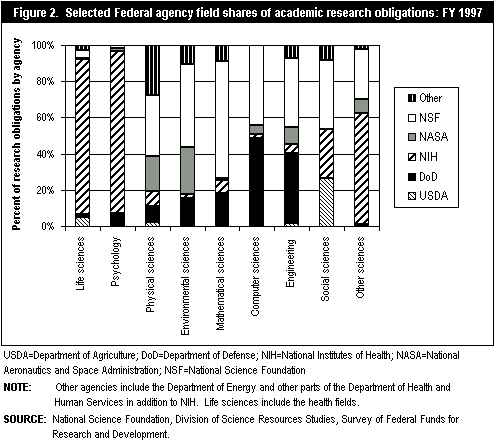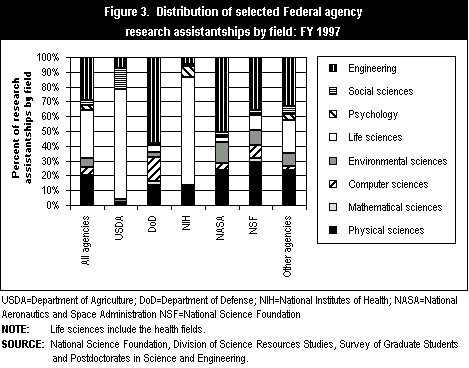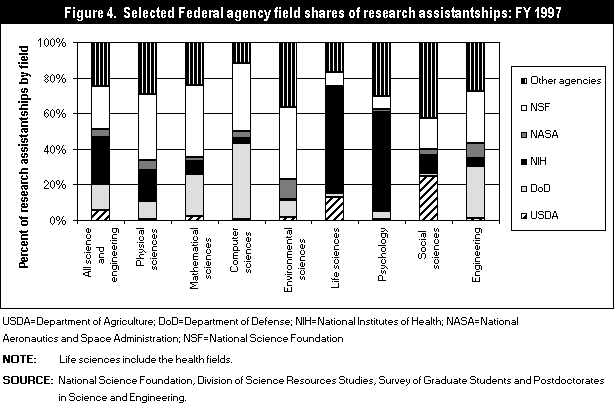
Directorate for Social, Behavioral
and Economic Sciences
NSF 99-342 April 16, 1999

The level and distribution of Federal academic R&D funds and graduate student support result from the funding decisions of individual agencies.
Federal agencies emphasize different S&E fields in their funding of academic research and in their support of graduate students.
The Federal Government is a major financial supporter of both academic research and development (R&D) and science and engineering (S&E) graduate students. The overall level and the distribution of both its academic R&D and graduate student support result from the funding decisions of individual agencies. The agencies' different missions lead them to adopt different emphases in the fields they support and in their R&D and graduate assistance programs. For many of these agencies, the major form of graduate student support is indirect, through research assistantships, rather than through direct fellowships or traineeships.
The balance of academic R&D funding across agencies is therefore likely to affect the distribution of support among both S&E fields and graduate students. This Issue Brief examines the current (1997) distribution of Federal agencies' academic R&D support across S&E fields, the nature and distribution of their graduate student support, and their relative importance in the Federal support received by specific S&E fields.[1]
In 1997, the Federal Government provided an estimated 60 percent of academic R&D funds. It also was the primary source of financial support for 20 percent of all full-time S&E graduate students (30 percent if those whose primary support is from own, spouse, or family resources are excluded). However, for half of those students whose primary support mechanism was a research assistantship (RA), the Federal Government was the primary source of financial support.
Federal obligations for academic R&D are concentrated in a small number of agencies. The National Institutes of Health (NIH), the National Science Foundation (NSF), the Department of Defense (DoD), the National Aeronautics and Space Administration (NASA), and the Department of Agriculture (USDA) combined provided an estimated 91 percent of total Federal financing in 1997.[2] Federal support for S&E graduate students is also relatively concentrated in the same five agencies: 75 percent of all students with primary support from the Federal Government and also 75 percent of students whose primary mechanism is a federally funded RA.[3]
|
Percent of academic
R&D support |
Percent of federally
funded RAs |
|
| · NIH |
56
|
24[4]
|
| · NSF |
14
|
25
|
| · DoD |
11
|
15
|
| · NASA |
6
|
5
|
| · USDA |
4
|
6
|
Federal Academic Research Support by Field[5]
Federal agencies emphasize different S&E fields in their funding of academic
research. Several agencies concentrate much of their funding in one field.
NIH spends 89 percent of its funds on the life sciences.[6]
USDA also spends three-quarters of its academic research funds in the
same field.[7] Other agencies-NSF,
NASA, and DoD-have more diversified funding patterns. About 20 percent
of NSF funds each go to the physical sciences and engineering, with another
16-17 percent to both the life sciences and the environmental (earth,
atmospheric, and oceanographic) sciences. NASA's distribution is 37 percent
to the physical sciences, 29 percent to the environmental sciences, and
15 percent to engineering. DoD provides 40 percent of its academic research
support to engineering, 23 percent to the computer sciences, about 11
percent to the physical sciences, and 10 percent to both the life and
environmental sciences (figure 1).
Even though an agency may place a large share of its academic research funds in one field, it may not be a leading contributor to that field (figure 2). NSF is the lead funding agency in the physical sciences (34 percent of total funding), the mathematical sciences (65 percent), the social sciences (38 percent), and the environmental sciences (46 percent). DoD is the lead funding agency in computer science (49 percent) and engineering (38 percent). NIH is the lead funding agency in the life sciences (86 percent) and psychology (89 percent). Within finer S&E field classifications, other agencies take the leading role.[8]
Agency Support of S&E Graduate Research Assistantships
by Field
Just as Federal agencies emphasize different S&E fields in their funding
of academic research, they also emphasize different fields in their support
of graduate research assistants. NIH concentrates its RA support in the
life sciences (73 percent), as does USDA (74 percent). DoD and NASA concentrate
their RA support in engineering (58 and 51 percent, respectively). NSF,
on the other hand, has a more diversified RA support pattern, with 36
percent in engineering, 29 percent in the physical sciences, and 10 percent
in both the environmental and computer sciences (figure
3).
In terms of agencies' importance to Federal graduate RAs in particular fields (figure 4):
- NSF is the lead supporting agency in the mathematical sciences (41 percent of federally supported RAs), the environmental sciences (41 percent), the physical sciences (37 percent), and in engineering (29 percent).
- NIH is the lead support agency in the life sciences (60 percent) and psychology (56 percent).
- DoD is the lead support agency in the computer sciences (43 percent).[9]



